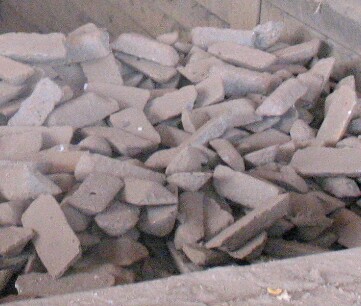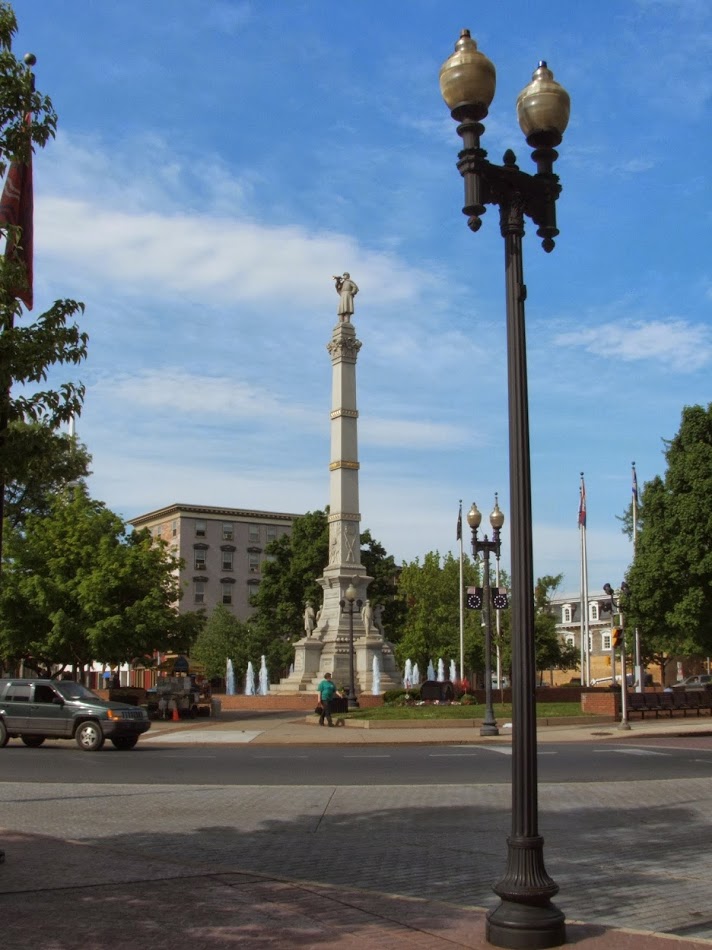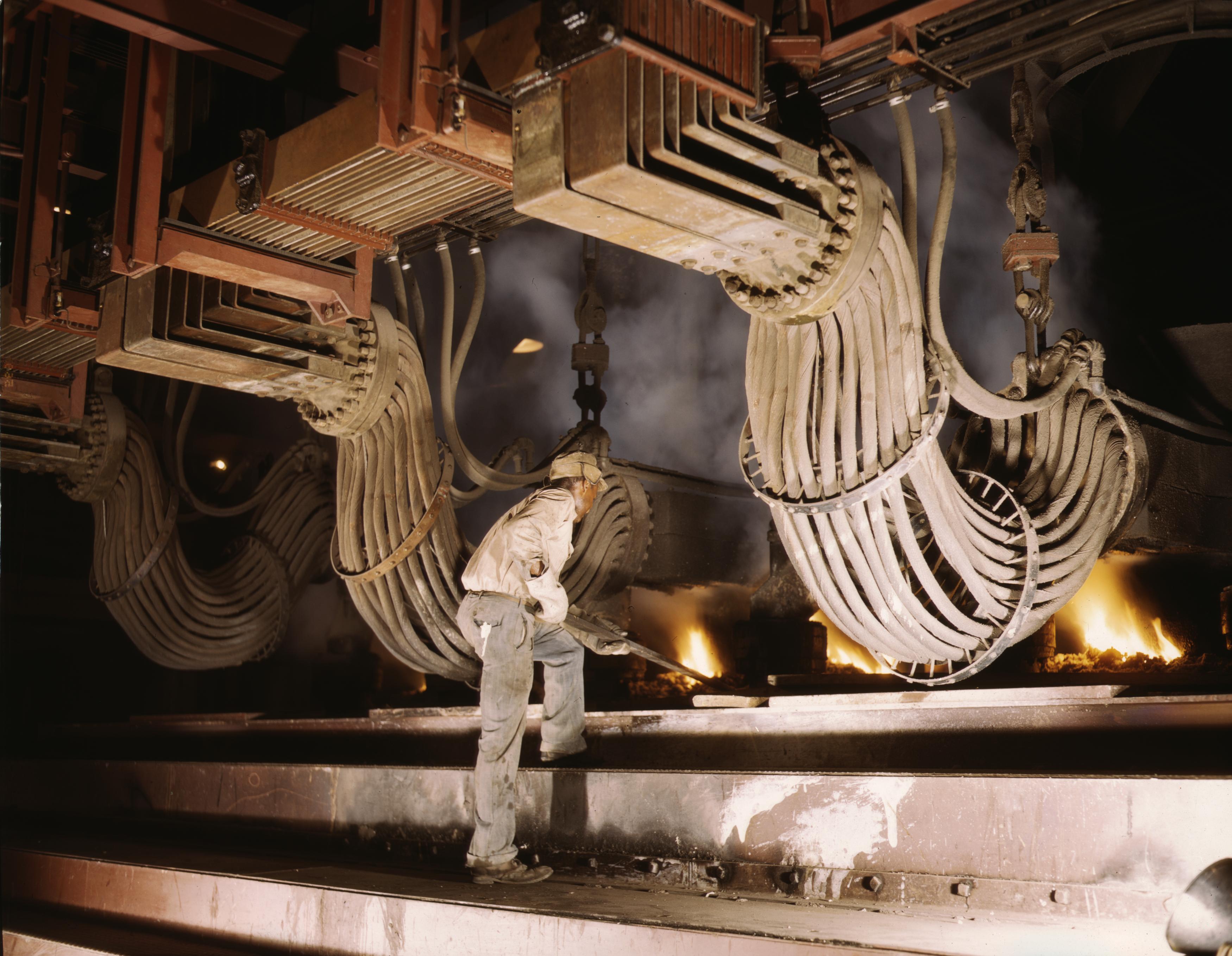|
Catasauqua Creek
Catasauqua Creek is an ENE–SSW oriented creek draining (straight line distance) from springs of the Blue Mountain barrier ridge several miles below the Lehigh Gap in the ridge-and-valley Appalachians located upriver and opposite from Allentown in Lehigh and Northampton counties in the Lehigh Valley region of eastern Pennsylvania. The mouth of the creek outlets directly opposite West Catasauqua just below Race Street bridge across the Lehigh River, the latest of the several successor structures built to replace the original wooden bridge built in 1839-1840 to carry heavy wagons of iron ore to the new furnaces being built within the new village aborning as the Lehigh Crane Iron Company created the infrastructure to father the iron and steel industry of the Lehigh Valley. The head of the Creek begins in the Dannersville neighborhood of Bath at 40°44′16″N latitude 75°25′58″W longitude (or 40.737849,-75.432824) forming a steep sided ravine almost immediately as it ... [...More Info...] [...Related Items...] OR: [Wikipedia] [Google] [Baidu] |
Catasauqua, Pennsylvania
Catasauqua, referred to colloquially as Catty, is a borough in Lehigh County, Pennsylvania. Catasauqua's population was 6,518 at the 2020 census. It is a suburb of Allentown in the Lehigh Valley, which had a population of 861,899 and was the 68th most populous metropolitan area in the U.S. as of the 2020 census. In 1839, Catasauqua was the location of the first manufactured anthracite iron in the nation. The borough was settled in 1805 and chartered in 1853. Geography Catasauqua is located at (40.652995, -75.467627). Nearby large communities include Allentown three miles (5 km) to the south and Bethlehem seven miles (11 km) to the east. According to the U.S. Census Bureau, the borough has a total area of , of which is land and 0.04 square mile (0.10 km2 or 2.31%) is water. Catasauqua Creek flows through the town. Lehigh River runs along the southwestern edge of Catasauqua. Neighboring municipalities * Hanover Township * North Catasauqua * Whitehall Towns ... [...More Info...] [...Related Items...] OR: [Wikipedia] [Google] [Baidu] |
Longitude
Longitude (, ) is a geographic coordinate that specifies the east– west position of a point on the surface of the Earth, or another celestial body. It is an angular measurement, usually expressed in degrees and denoted by the Greek letter lambda (λ). Meridians are semicircular lines running from pole to pole that connect points with the same longitude. The prime meridian defines 0° longitude; by convention the International Reference Meridian for the Earth passes near the Royal Observatory in Greenwich, England on the island of Great Britain. Positive longitudes are east of the prime meridian, and negative ones are west. Because of the Earth's rotation, there is a close connection between longitude and time measurement. Scientifically precise local time varies with longitude: a difference of 15° longitude corresponds to a one-hour difference in local time, due to the differing position in relation to the Sun. Comparing local time to an absolute measure of ti ... [...More Info...] [...Related Items...] OR: [Wikipedia] [Google] [Baidu] |
Pig Iron
Pig iron, also known as crude iron, is an intermediate product of the iron industry in the production of steel which is obtained by smelting iron ore in a blast furnace. Pig iron has a high carbon content, typically 3.8–4.7%, along with silica and other constituents of dross, which makes it brittle and not useful directly as a material except for limited applications. The traditional shape of the molds used for pig iron ingots is a branching structure formed in sand, with many individual ingots at right angles to a central channel or "runner", resembling a litter of piglets being nursed by a sow. When the metal had cooled and hardened, the smaller ingots (the "pigs") were simply broken from the runner (the "sow"), hence the name "pig iron". As pig iron is intended for remelting, the uneven size of the ingots and the inclusion of small amounts of sand cause only insignificant problems considering the ease of casting and handling them. History Smelting and producing ... [...More Info...] [...Related Items...] OR: [Wikipedia] [Google] [Baidu] |
David Thomas (industrialist)
David Thomas (November 3, 1794 – June 20, 1882) was a native of Wales who was influential in the birth of the Industrial Revolution in the United States. Development of the hot blast David Thomas was born in Cadoxton, near Neath. He went to school at nearby Alltwen and at Neath, and worked on his father's farm before going into the iron industry. He married Elizabeth Hopkins in 1817. As an adult, he was widely regarded as one of the foremost ironmasters in the United Kingdom. It was while employed at the Yniscedwyn Works, in Ystradgynlais in the Swansea Valley, that he devised the process which would advance the Industrial Revolution. On February 5, 1837, Thomas used a hot blast to smelt iron ore and anthracite coal. The result was an easy method to produce anthracite iron, which revolutionized industry in the Swansea Valley. This type of iron had been patented by Edward Martin of Morriston, Wales in 1804. In 1839 he relocated to Pennsylvania, where the owners of the Lehigh ... [...More Info...] [...Related Items...] OR: [Wikipedia] [Google] [Baidu] |
Lehigh Coal & Navigation Company
The Lehigh Coal & Navigation Company was a mining and transportation company headquartered in Mauch Chunk, Pennsylvania, now known as Jim Thorpe, Pennsylvania. The company operated from 1818 until its dissolution in 1964 and played an early and influential role in the rise of the American Industrial Revolution and early U.S. industrialization. The company ultimately encompassed source industries, transport, and manufacturing, making it the first vertically integrated U.S. company.Archer B. HulbertThe Paths of Inland Commerce, A Chronicle of Trail, Road, and Waterway, Vol. 21, The Chronicles of America Series. Editor: Allen Johnson (1921) Building on two predecessor companies incorporated in 1818,, 627 pages (pdf) founders Erskine Hazard and Josiah White entered the coal industry to serve customers seeking a steady supply of fuel for foundries and mills on the falls of the Schuylkill River. Its role in accelerating regional industrial development by taking on civil engineering ... [...More Info...] [...Related Items...] OR: [Wikipedia] [Google] [Baidu] |
Josiah White
Josiah White (1781–1850) was a Pennsylvania industrialist and key figure in the American Industrial Revolution. Career White began early factory-centered mill production in 1808 in water powered ironworks near Philadelphia, along with his partner, Erskine Hazard, when they quickly found that their first mill at the East Falls, Pennsylvanial to be much too small. Subsequently, they built a more elaborate and larger mill nearby to refine pig iron and produce cast iron artifacts and roll wrought bar iron goods, including nails and wire. The pair were especially influential after 1814 in helping make the American Industrial Revolution accelerate its building momentum by agitating for infrastructure investment, sponsoring two key river navigations and the nation's first long railway, and then after initial success, increasingly supplying an expanding part of the country's overall energy needs including that of other industrialists at a time when there occurred the prolonged fir ... [...More Info...] [...Related Items...] OR: [Wikipedia] [Google] [Baidu] |
Erskine Hazard
Erskine Hazard (1790-1865), a younger son of the first U.S. Postmaster Ebenezer Hazard, became the partner of Josiah White about 1810 when around 19 years old. White and Hazard together established spearheaded efforts that enabled the Industrial Revolution, the advancement of steam power, and of railroading, creating the infrastructure and business climate to accelerate the Northeast U.S. out of an agrarian society to the industrial power that served as a foundation for the rise of the United States as the world's foremost economic power. The Partnership Together they put together the wherewithal to open a foundry and wire drawing plant on the falls of the Schuylkill River near Philadelphia in 1810. Their first reputation establishing event was to build a small suspension bridge across the Schuylkill in order to better demonstrate their factory. When the US President put an embargo in place on Bituminous Coal imports from Great Britain in the tension prior to the War of 1812, the ... [...More Info...] [...Related Items...] OR: [Wikipedia] [Google] [Baidu] |
Water Power
Hydropower (from el, ὕδωρ, "water"), also known as water power, is the use of falling or fast-running water to produce electricity or to power machines. This is achieved by converting the gravitational potential or kinetic energy of a water source to produce power. Hydropower is a method of sustainable energy production. Hydropower is now used principally for hydroelectric power generation, and is also applied as one half of an energy storage system known as pumped-storage hydroelectricity. Hydropower is an attractive alternative to fossil fuels as it does not directly produce carbon dioxide or other atmospheric pollutants and it provides a relatively consistent source of power. Nonetheless, it has economic, sociological, and environmental downsides and requires a sufficiently energetic source of water, such as a river or elevated lake. International institutions such as the World Bank view hydropower as a low-carbon means for economic development. Since ancient time ... [...More Info...] [...Related Items...] OR: [Wikipedia] [Google] [Baidu] |
Easton, Pennsylvania
Easton is a city in, and the county seat of, Northampton County, Pennsylvania, United States. The city's population was 28,127 as of the 2020 census. Easton is located at the confluence of the Lehigh River, a river that joins the Delaware River in Easton and serves as the city's eastern geographic boundary with Phillipsburg, New Jersey. Easton is the easternmost city in the Lehigh Valley, a region of that is Pennsylvania's third largest metropolitan region with 861,889 residents as of the U.S. 2020 census. Of the Valley's three major cities, Allentown, Bethlehem, and Easton, Easton is the smallest with approximately one-fourth the population of Allentown, the Valley's largest city. The greater Easton area includes the city of Easton, three townships ( Forks, Palmer, and Williams), and three boroughs ( Glendon, West Easton, and Wilson). Centre Square, the city's town square in its downtown neighborhood, is home to the Soldiers' and Sailors' Monument, a memorial for E ... [...More Info...] [...Related Items...] OR: [Wikipedia] [Google] [Baidu] |
Blast Furnace
A blast furnace is a type of metallurgical furnace used for smelting to produce industrial metals, generally pig iron, but also others such as lead or copper. ''Blast'' refers to the combustion air being "forced" or supplied above atmospheric pressure. In a blast furnace, fuel (coke (fuel), coke), ores, and Flux (metallurgy), flux (limestone) are continuously supplied through the top of the furnace, while a hot blast of air (sometimes with oxygen enrichment) is blown into the lower section of the furnace through a series of pipes called tuyeres, so that the #Process engineering and chemistry, chemical reactions take place throughout the furnace as the material falls downward. The end products are usually molten metal and slag phases tapped from the bottom, and waste gases (flue gas) exiting from the top of the furnace. The downward flow of the ore along with the flux in contact with an upflow of hot, carbon monoxide-rich combustion gases is a countercurrent exchange and chemical ... [...More Info...] [...Related Items...] OR: [Wikipedia] [Google] [Baidu] |
Hot Blast
Hot blast refers to the preheating of air blown into a blast furnace or other metallurgical process. As this considerably reduced the fuel consumed, hot blast was one of the most important technologies developed during the Industrial Revolution. Hot blast also allowed higher furnace temperatures, which increased the capacity of furnaces. As first developed, it worked by alternately storing heat from the furnace flue gas in a firebrick-lined vessel with multiple chambers, then blowing combustion air through the hot chamber. This is known as regenerative heating. Hot blast was invented and patented for iron furnaces by James Beaumont Neilson in 1828 at Wilsontown Ironworks in Scotland, but was later applied in other contexts, including late bloomeries. Later the carbon monoxide in the flue gas was burned to provide additional heat. History Invention and spread James Beaumont Neilson, previously foreman at Glasgow gas works, invented the system of preheating the blast for a f ... [...More Info...] [...Related Items...] OR: [Wikipedia] [Google] [Baidu] |
Smelting
Smelting is a process of applying heat to ore, to extract a base metal. It is a form of extractive metallurgy. It is used to extract many metals from their ores, including silver, iron, copper, and other base metals. Smelting uses heat and a chemical reducing agent to decompose the ore, driving off other elements as gases or slag and leaving the metal base behind. The reducing agent is commonly a fossil fuel source of carbon, such as coke—or, in earlier times, charcoal. The oxygen in the ore binds to carbon at high temperatures due to the lower potential energy of the bonds in carbon dioxide (). Smelting most prominently takes place in a blast furnace to produce pig iron, which is converted into steel. The carbon source acts as a chemical reactant to remove oxygen from the ore, yielding the purified metal element as a product. The carbon source is oxidized in two stages. First, the carbon (C) combusts with oxygen (O2) in the air to produce carbon monoxide (CO). Seco ... [...More Info...] [...Related Items...] OR: [Wikipedia] [Google] [Baidu] |



_Erskine_Hazard_(1790-1865).jpg)
.jpg)


